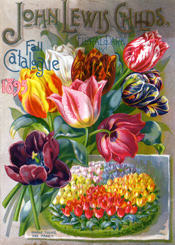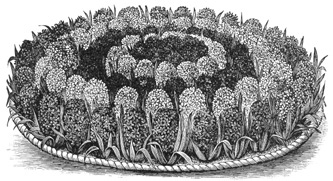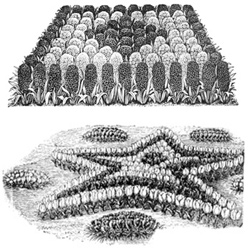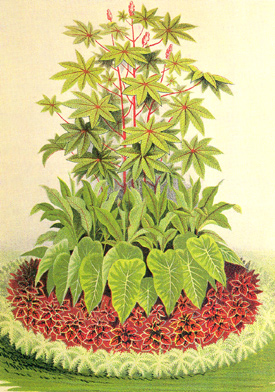Bulbs per Square Feet — for Pattern-Beds or Anywhere
“How many bulbs do I need to fill this space?” That’s a question gardeners ask us often enough that we put together this page to help answer it.

Single Early tulips, 1895
But a century ago it would have been a MUCH more frequently asked question. That’s because from about 1850 to 1920, a planting style known as bedding-out, pattern-bedding, or carpet-bedding was wildly popular.
As Denise Adams explains in her excellent Restoring American Gardens, the “Victorians did with bulbs what they did with any brightly colored flowers — they used them in brilliant, flamboyant bedding schemes and carpet patterns” planted in the middle of their lawns. It’s a style that survives in public plantings today, from Keukenhof to Disney World, and though you may not want a 20-foot floral clock on your lawn, recreating a simple pattern-bed can be easy and fun.
Spring Pattern-Bedding
In the early years of bedding-out, patterns within the beds were unheard of. Instead, each was filled with a single variety such as the brilliant red-and-yellow tulip, ‘Keizerskroon’. But Victorian taste soon led to much more elaborate designs.

Peter Henderson catalog, 1903
Hyacinths and early tulips were always the most favored bulbs for spring bedding. Adams writes that “geometric beds were filled with one or the other, with admonitions from the arbiters of taste not to mix the two in a single bed.” Among the simplest of pattern-beds were circular beds filled with concentric rings of different colored tulips or hyacinths. In this hyacinth bed from the 1903 catalog of Peter Henderson, three color schemes were suggested, each starting from the outer circle: (1) “crimson” (such as ‘Vuurbaak’), white, purple, white, crimson; (2) blue, white, rose, lavender, pink, and (3) pink, lavender, crimson, white, pink.
Bulbs for Round and Oval Beds
In their 1930 catalog, the Zandbergen Brothers of Oyster Bay, NY, included a table listing the number of bulbs needed to plant a round bed measuring from 3 to 20 feet wide. We’ve reproduced part of the table below, with additional columns for bulbs planted 3 inches apart (such as crocus) and 18 inches apart (such as lilies).
If your bed is oval instead of round, they explained, “add the length and breadth and divide by two. [An oval] bed 6 feet wide and 8 feet long will require the same number of bulbs as a round bed 7 feet in diameter. (6 plus 8 is 14; divided by 2 leaves 7.)”
| Number of Bulbs for Planting a Round Bed | |||||
|---|---|---|---|---|---|
| diameter | 3” apart | 6” apart | 8” apart | 12” apart | 18” apart |
| 3 feet | 120 | 28 | 16 | 7 | 3 |
| 4 feet | 200 | 48 | 28 | 12 | 6 |
| 5 feet | 312 | 80 | 44 | 20 | 9 |
| 6 feet | 425 | 112 | 64 | 28 | 13 |
| 7 feet | 600 | 152 | 87 | 38 | 17 |
| 8 feet | 800 | 200 | 100 | 50 | 22 |
| 9 feet | 1025 | 256 | 143 | 64 | 28 |
| 10 feet | 1250 | 320 | 150 | 80 | 35 |
| 11 feet | 1500 | 380 | 214 | 95 | 42 |
| 12 feet | 1700 | 452 | 255 | 113 | 50 |
Or for Beds of Any Shape
Not every space you’ll want to fill with bulbs will be round or oval, but don’t worry. You can figure how many bulbs you’ll need for ANY space by calculating its area and then using the table below. And just in case your memory of high school geometry is less than perfect, here are the basic formulas you’ll need.

Peter Henderson catalog, 1903
BEFORE you start, convert measurements from inches to feet by dividing the number of inches by 12. Then . . .
For a SQUARE or RECTANGLE: Multiply the length by the width. Length x width = area.
For a TRIANGLE: Multiply the base by the height, then divide that number by 2. The base is the longest side. The height is the distance from the base to the opposite angle. (Base x height)/2 = area.
For a CIRCLE: Figure the radius by dividing the diameter (the width) by 2. Multiply the radius by itself, then multiply that number by 3.14 (pi). (Diameter/2) x (diameter/2) x 3.14 = area.
NOTE: We couldn’t include every possible area in this table, but here are some examples. For other areas, simply multiply the total square feet by the number of bulbs in the row labeled “1 square foot.” For example, if you want to fill 38 square feet with bulbs 6 inches apart, you’ll need 38 x 4 = 152 bulbs.
| Number of Bulbs Needed by Square Feet | |||||
|---|---|---|---|---|---|
| area | 3” apart | 6” apart | 8” apart | 12” apart | 18” apart |
| 1 square foot | 16 | 4 | 2 | 1 | 1/2 (.44) |
| 5 square feet | 80 | 20 | 11 | 5 | 2 |
| 8 square feet | 128 | 32 | 18 | 8 | 4 |
| 10 square feet | 160 | 40 | 23 | 10 | 5 |
| 25 square feet | 400 | 100 | 56 | 25 | 11 |
| 50 square feet | 800 | 200 | 113 | 50 | 22 |
| 100 square feet | 1600 | 400 | 225 | 100 | 44 |
| 150 square feet | 2400 | 600 | 338 | 150 | 67 |
Tips for Planting the Bulbs
The Zandbergens also offered guidance on the planting itself. “Plant outside rows first,” they advised. (Gardeners probably knelt on boards to keep from compacting the soil as they worked their way toward the center.) Bulbs “planted 6 inches apart should be placed 3 inches from the edge of the bed; those 12 inches apart should be placed 6 inches from the edge.” And here’s a savvy tip: “It is advisable to plant the outer rows more closely than those toward the center.”
Summer Pattern-Bedding
Summer bedding was even more popular than spring bedding. In summer beds, exotic sub-tropical bulbs such as cannas, dahlias, and elephant ears were mixed with colorful annuals such as petunias, geraniums, and coleus which were newly arrived from the far corners of the globe.

Vick’s Monthly Illustrated Magazine
This widely-reprinted image from an 1878 issue of Vick’s Monthly Illustrated Magazine shows a fashionable “foliage” pattern-bed. In the center is an 8-foot-tall castor bean (Ricinus communis), a dramatic annual that’s easy to grow from seeds — which, unfortunately, are very poisonous. It’s surrounded by cannas (4-5 feet tall), elephant ears (3-4 feet), red coleus (1-2 feet), and silvery dusty miller (Senecio cineraria, 6-12 inches).
Since all of these plants are still widely available, you could easily reproduce this exuberant planting in your front lawn today. Or you could use it as a model for creating your own summer pattern-bed. The possibilities, of course, are endless, but here are a few relatively authentic Victorian choices to get you started.
Tallest Plants (in original design = castor bean, poisonous!): banana, canna ‘Ehemanii’, dahlia ‘Jersey’s Beauty’, Mexican sunflower (Tithonia), ornamental grasses, potted palm
Medium-Tall Plants (original = cannas): dahlia ‘Bishop of Llandaff‘, hibiscus, kiss-me-over-the-garden-gate (Polygonum orientale)
Medium-Short Plants (original = elephant ears): cannas, four o’clocks (Mirabilis), tall salvia
Short Plants (original = coleus): caladium, celosia, dwarf dahlias, geraniums, salvia, verbena
Edging Plants (original = dusty miller): ageratum, alternanthera, alyssum, golden feverfew (Tanacetum parthenium ‘Aureum’), lobelia, petunias, verbena
We hope we’ve helped and maybe even inspired you. If you try a bit of bedding out yourself, or see a great example of it elsewhere, we’d love to hear from you at help@oldhousegardens.com. Photos are welcome, too. Happy gardening!












